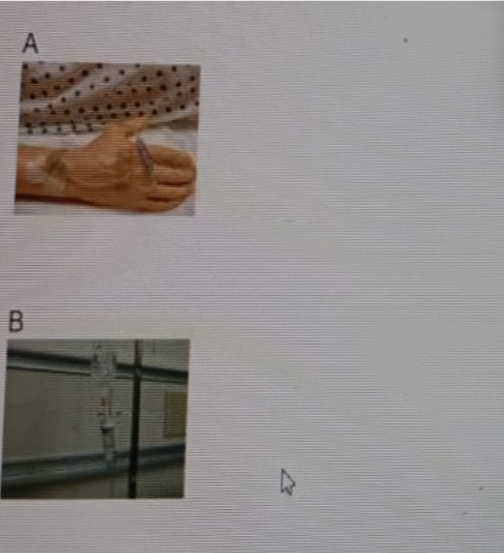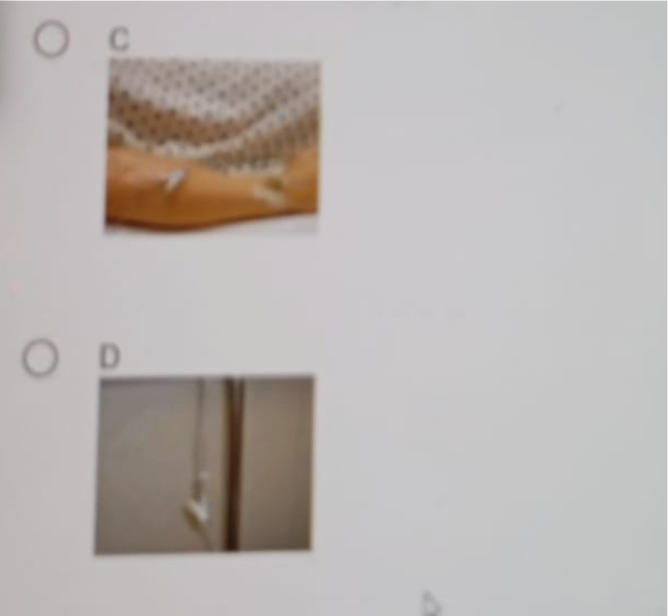A client is receiving IV fluids by gravity infusion and exhibits signs of fluid volume overload. When assessing the client's IV delivery system, where should the nurse assess first?


A
B
C
D
None
None
The Correct Answer is D
Rationale:
A: This shows the IV insertion site on the hand. While important for checking infiltration or phlebitis, it does not affect flow rate or volume delivered, so it's not the priority in fluid overload.
B: This shows the IV drip chamber. This is the first place to assess because it allows the nurse to determine how fast the IV fluid is infusing. It provides a quick visual cue of the actual flow rate, which is essential in evaluating whether the infusion is too fast, the likely cause of the overload.
C: This is the IV tubing near the insertion site. Kinks or dislodgement can affect flow, but it’s not the most immediate concern when fluid overload is suspected.
D: Shows the roller clamp, this directly controls the flow rate in a gravity system, so it is the place to intervene when fluid overload is suspected. After assessing the flow rate in the drip chamber and confirming fast infusion, the nurse should adjust the flow rate at this part.
Nursing Test Bank
Naxlex Comprehensive Predictor Exams
Related Questions
Correct Answer is ["125"]
Explanation
Calculation:
- Convert the total volume from liters (L) to milliliters (mL).
Total volume = 1 L × 1000 mL/L
= 1000 mL.
Infusion time = 8 hours.
- Calculate the infusion rate in milliliters per hour (mL/hour).
Infusion rate (mL/hour) = Total volume (mL) / Infusion time (hour)
= 1000 mL / 8 hours
= 125 mL/hour.
Answer: 125
Correct Answer is D
Explanation
Rationale:
A. A family member expresses concern about their relative "picking" at the nasogastric (NG) tube: Family concern should be acknowledged, but restraint use must be based on clinical necessity. The nurse can first implement non-restrictive interventions before considering restraints.
B. A client is walking the halls at night rubbing his hands together: This behavior does not indicate harm to self or others or interference with medical devices. There is no justification for restraint, and doing so could violate patient rights and ethical standards.
C. A 16-year-old boy swung his fist at the nurse: This may call for emergency behavioral restraints rather than mitten restraints. If the behavior poses a threat of violence, other forms of crisis intervention or behavioral management should be pursued first.
D. A disoriented client removed the mesh-wrapped intravenous (IV) line for the second time: Mitten restraints may be considered when a client repeatedly removes critical lines or tubes, especially when cognitively impaired. This situation meets the clinical indication for discussing their use with the provider to prevent treatment disruption while ensuring safety.
Whether you are a student looking to ace your exams or a practicing nurse seeking to enhance your expertise , our nursing education contents will empower you with the confidence and competence to make a difference in the lives of patients and become a respected leader in the healthcare field.
Visit Naxlex, invest in your future and unlock endless possibilities with our unparalleled nursing education contents today
Report Wrong Answer on the Current Question
Do you disagree with the answer? If yes, what is your expected answer? Explain.
Kindly be descriptive with the issue you are facing.
